Are you ready to embrace full-on baby-led weaning? Or do you see yourself using a combined approach, offering both finger food and food from a spoon? Whichever you decide, finger food has a lot to offer you and your baby. In this blog, you’ll find ideas on how and when to offer finger foods for babies.
It’s worth keeping in mind that while you might have a fixed idea about how to approach weaning, your baby might have their own plans. It didn’t take my first little guy long to shun the spoon in favour of feeding himself finger food. At the same time, my second and third little fellas were happy with both methods. My little girl, on the other hand, was a finger food advocate from day one, no spoon-feeding for her.
What is the best age to start finger foods?
Your baby benefits from eating finger foods, whether you’re planning 100% baby-led feeding or using a combined approach to weaning! But either way, you need to keep your baby safe as they learn how to manage whole food.
The most important thing is to wait until your baby is developmentally ready. But, what does this mean?

It’s simple. Three clear signs show your baby is ready. And your baby needs to show ALL of them. This will be at or around six months of age but will depend on each baby. Babies born prematurely or those who are slower developmentally may not be ready for finger food until later than this. Watch your baby, not the clock.
Number 1
Can your baby hold their head steady?
Why? It’s pretty tricky, not to mention dangerous, to eat with your chin on your chest.
Number 2
Can your baby sit up with little to no support?
Why? Have you ever tried to eat while you’re flopping around in your chair? It’s not fun, nor is it safe or effective!
Number 3
Can your baby reach, grab and put toys and teethers into their mouth?
Why? Because some hand-eye coordination is vital for self-feeding. This will improve with practice. So, before you get out the broccoli, let your baby practice with their toys.
And, just to be absolutely clear! Being interested in your food isn’t NOT a reliable sign that your baby is developmentally ready for traditional or baby-led weaning!
LEARN MORE >>> I’m confused. When is my baby ready for solids?
If your baby isn’t quite ready yet, then wait. And get your baby prepared by helping them strengthen their trunk and head control through tummy time and by giving them lots of opportunities to grab and mouth teething toys.
Why introduce finger foods to your baby?
Benefits for your BABY of introducing finger foods include:
- Improved fine motor skills and coordination
- Development of ‘pincer grasp’. This is the ability to hold something between the thumb and first finger
- Learning about the social aspects of family meals as it’s more likely you’ll be eating similar food
- Development of oral muscles in your baby’s mouth that they’ll need later for speaking
- Moving on with texture is an integral part of the feeding process
- Ability to control portion sizes of solid foods and balance milk (especially breast milk) and solids.
- The mess. OK, it’s a different story when you’re on your hands and knees cleaning the floor. But, weaning should be a messy process. It’s how your baby learns about the texture, smell and flavour of the food before it ever gets to their mouth!
Benefits to YOU of introducing finger foods include:
- Ease- it’s relatively easy to adapt family foods for your baby.
- Convenience-it’s more straightforward to travel out and about with steamed carrots and grated cheese than a chicken casserole!
- It may reduce fussy eating. Although, we don’t have enough evidence to say this is for sure.
- You can get on with eating YOUR food.
Is it safe to offer baby finger food?
Offering your baby finger foods from six months onwards is safe, provided that you follow some safety guidelines.
“Infants following a baby-led approach to feeding that includes advice on minimising choking risk do not appear more likely to choke than infants following more traditional feeding practices”
BLISS STUDY, 2016.
LEARN MORE >>> Choking and baby-led weaning
What is the difference between the ‘palmar grasp’ and the ‘pincer grasp’?
When your baby starts with finger foods, they’ll use their palmar grasp to grab foods and bring them to their mouth. So, make it easy (and safe) for them by providing large, graspable and squashable foods.
As they get older, they’ll start to develop their pincer grasp. This means coordinating their index finger and thumb to pinch a small object (like some grated cheese). Developing the pincer skill is an essential milestone in your baby’s fine motor development.
Babies typically develop this skill between 9 and 10 months, although this can vary because babies develop at different rates.
You can offer smaller pieces of food before nine months so your baby can practice, but don’t be surprised if it takes quite a while for them to master them skillfully. By 12 months, most babies have usually perfected it. But each baby is different.
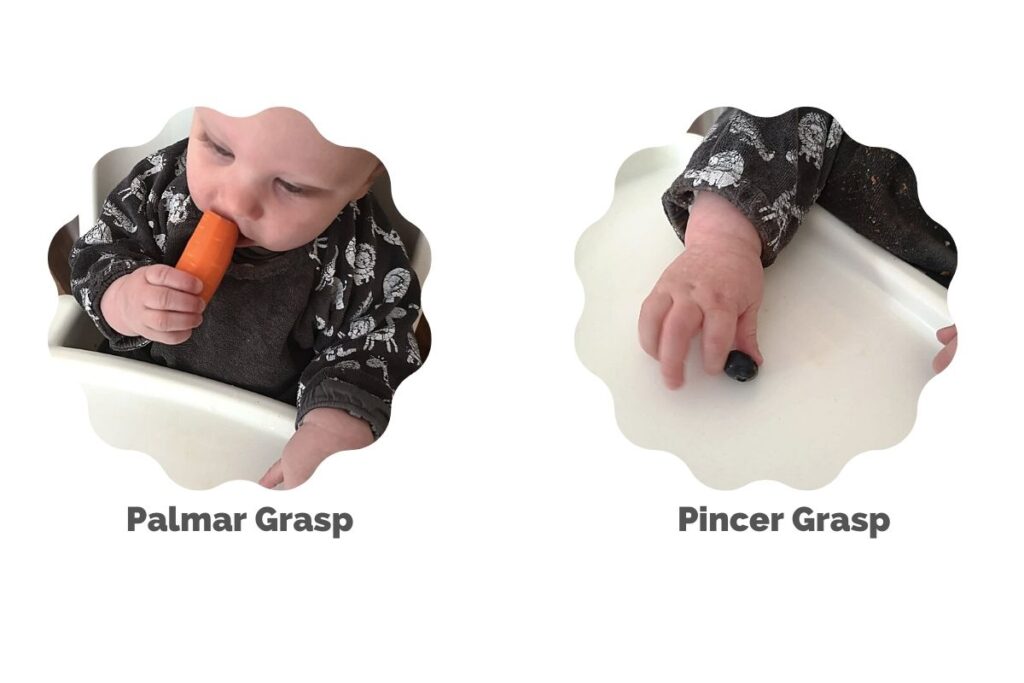
And remember, weaning is NOT about offering all one texture or size of food at each stage. It’s about providing your baby a variety of foods so they can eat what they need and practice their skills simultaneously.
If you provide ALL tiny pieces of food, it might take a frustratingly long time for your baby to fill their tummy. So, it’s OK to continue to offer large graspable food, too, even when they’ve mastered their pincer grip.
How many teeth does my baby need to introduce finger food safely?
Most parents wonder how their baby will manage solid food when they have no or very few teeth. Fear not. Having teeth isn’t that important for eating finger food.
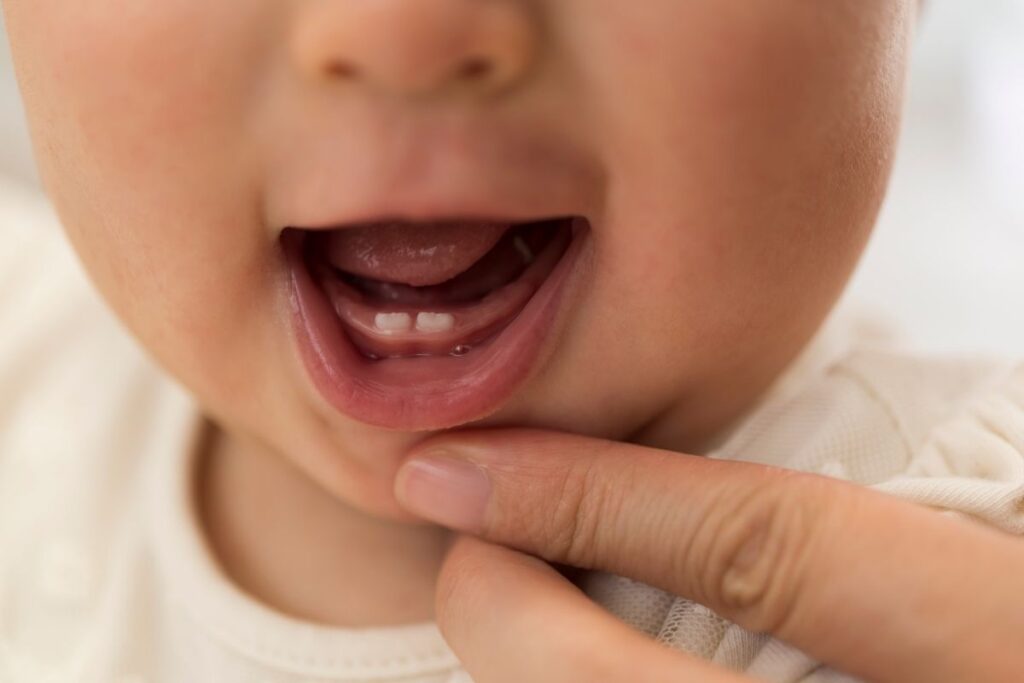
We use our teeth in two ways! We use our front teeth to tear off foods and our molars (the teeth on the sides of your mouth) to grind harder foods like tough meats. But your baby doesn’t need teeth to eat soft foods. Sometimes, it’s safer for your baby to eat certain things when they’re toothless. Because it makes it less likely they’ll be able to tear off a big piece of food.
Babies generally get their first molars from 14 months onwards and their second ones from 25 months on, so we can’t wait for these to appear before introducing finger foods. It would be far too late.
So, rather than using teeth, your baby uses its hard gums to eat finger foods. Stick your finger in your baby’s mouth, and you’ll quickly see how strong they are! So, what matters is not whether your baby has teeth but what texture the finger foods are.
First, finger foods should be soft and easily squashable between your fingers. That way, your baby can mash the food between their tongue and the roof of their mouth, making it safe to swallow.
A good high chair is vital for self-feeding
Believe it or not, choosing the right high chair is more important than you might think to help your baby feed themselves.

In summary, a good highchair:
1. Helps your baby to eat safely. Your baby should be sitting upright in its highchair. Never leaning backwards, reclined or on your lap while eating finger food.
2. Is comfortable, which encourages your baby to try new food.
3. Allows for improved self-feeding by keeping your baby at the right height to feed themselves.
4. Encourages enjoyable meals with the whole family. If your baby sees you enjoying the same food groups, they’re more likely to try them too!
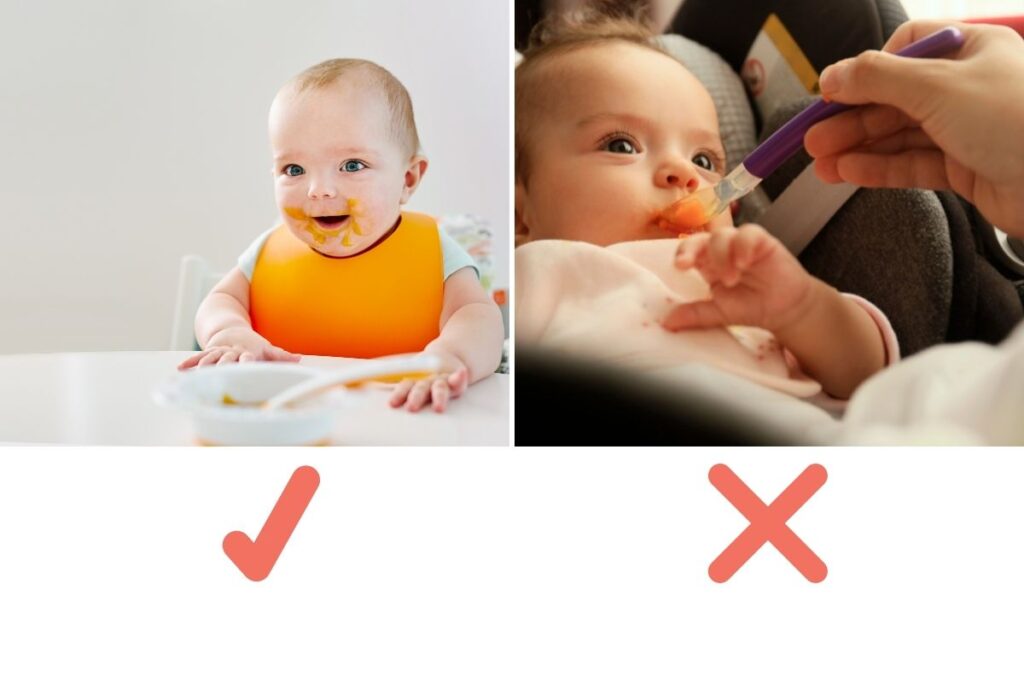
LEARN MORE >>> Ten pieces of weaning equipment to make your life easier
My baby gags when eating finger foods. Is this normal?
Before you start your baby on finger foods, it’s crucial you can distinguish between gagging, which is normal and choking, which is dangerous and potentially life-threatening.
LEARN MORE >>> Choking and baby-led weaning
Keep this phrase in mind to remind you when to intervene and when it’s OK to observe your baby.
“Loud and red, let them go ahead. Silent and blue, they need help from you.”
As a mum, I know that watching your baby’s eyes water, their face turn puce and listening to retching sounds isn’t fun. They may even vomit up some food. But gagging is nature’s way of protecting your baby’s airway. And it’s very common for all babies to gag, including those being spoon-fed. Although initially, your baby will gag more with finger foods than purées.
Even before introducing solids to your baby, help them control the gag reflex’s activation by encouraging them to ‘mouth’ toys with various textures. Only the back third of the tongue will stimulate a gag by about nine months, so gagging while eating will reduce.
Suitable foods for teething babies?
When babies are teething, it’s natural for them to show less interest in food. And although there are no magical ‘teething foods‘, offering your baby safe finger food to soothe their tender little gums is nice.
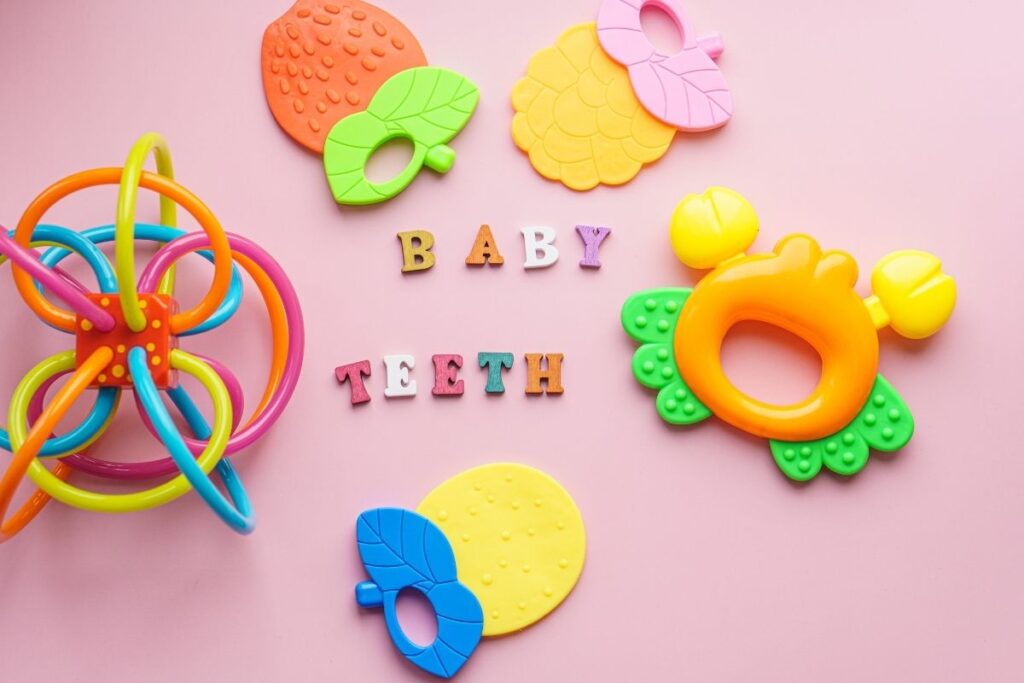
One trick is to pop any baby finger food like soft ripe fruit or soft-cooked vegetables into the fridge and serve cold. Peeled cucumber sticks are also a cooling food for babies who are more confident eaters.
You can freeze breastmilk, yoghurt or fruit and vegetable purées into a homemade ice-pop mould. And many babies find these very soothing as part of a meal.
Great finger foods for baby to start with
Keep it simple!
Remember, finger foods are just regular family meals that your baby eats with their fingers! At first, your baby can only grasp foods in their fist ‘palmar grasp’, so make sure the first foods are bigger rather than smaller.
And for safety, make sure that foods are soft enough to squash between your thumb and forefinger. In the words of one parent, “oh, you mean to cook the broccoli as my mother-in-law cooks it”!
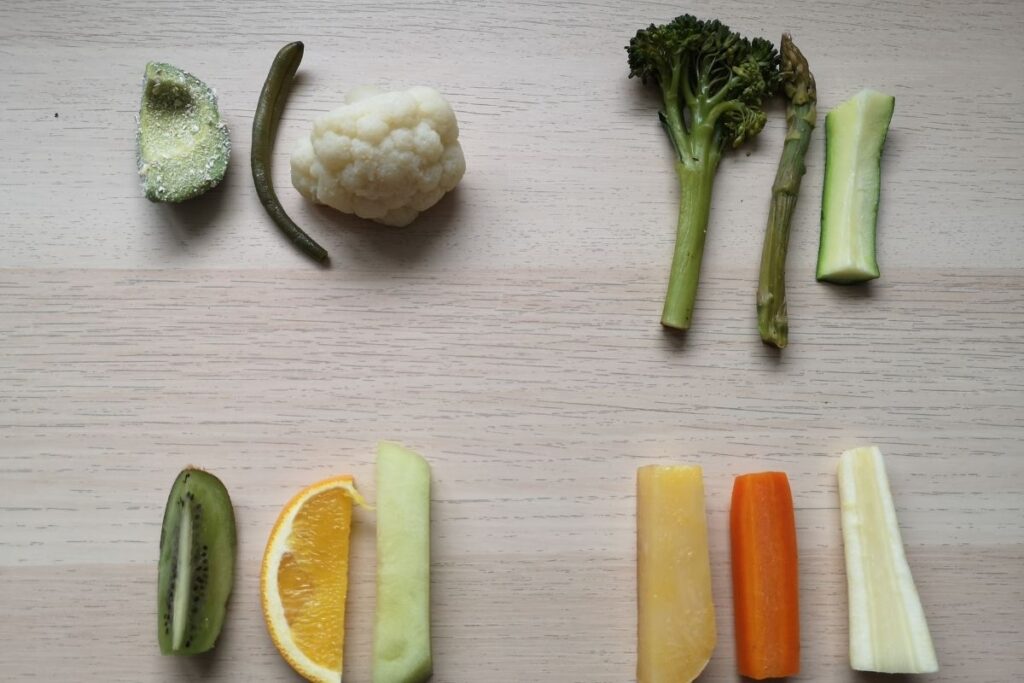
Starting finger food ideas
So, let’s quickly recap. Starting finger foods should be:
Squashable: Test food before letting your baby feed. Make sure the food is soft enough to mash easily between your two fingers.
The right size: Help your baby grasp the food by offering food at least as long as your baby’s fist on at least one side of the food. When you do this, the top of the food will stick out from your baby’s hand.
Not too hot: Make sure to let reheated or just cooked food cool slightly to room temperature or slightly warm before offering it to your baby.
Here are some effortless finger food ideas to get you started
Although you can choose from any food groups to get you started with finger foods, most parents generally opt to start weaning with vegetables and some fruits. Most fruit and vegetables are suitable, but I’ve listed some more popular options here.
Frozen Vegetables make perfect finger foods for babies.
Nutritionally frozen vegetables can be just as good if not better than fresh ones, and they also tend to have a softer texture than fresh ones. There are lots to try, but cauliflower, broccoli and green beans are generally the easiest ones to start with. Thanks to their slightly thicker shape and size.
You can either boil or steam these veggies until soft. I find steaming a lot easier when making as it’s easier to check that you’ve gotten the texture right. It’s much more challenging when you have to ‘catch’ the food first in a pan of boiling water!

Not all vegetables need to be cooked. Frozen avocado is handy, and you can defrost and serve.
Although avocado can be slippery, serve plain and have fun watching your baby manoeuvre it to their mouth. Or make it easier for your baby to eat it by rolling it in smooth oat cereal like Ready Brek, ground almonds or milled chia seeds. As well as grip, this provides extra nutrients, including iron which is vital for babies.
Green Vegetables with built-in handles are nature’s perfect finger food!
I’m a big fan of vegetable first weaning and especially starting with greens. And while most vegetables are perfect, some veggies like tender stem broccoli florets and asparagus have a very convenient in-built little handle that makes it easier for your baby to hold. And they can all be cooked in no time at all.
You can easily cut other green vegetables like cooked courgettes into a stick shape to make them easier to hold. It’s OK to leave the skin on, as once it’s cooked, it’ll be nice and soft.
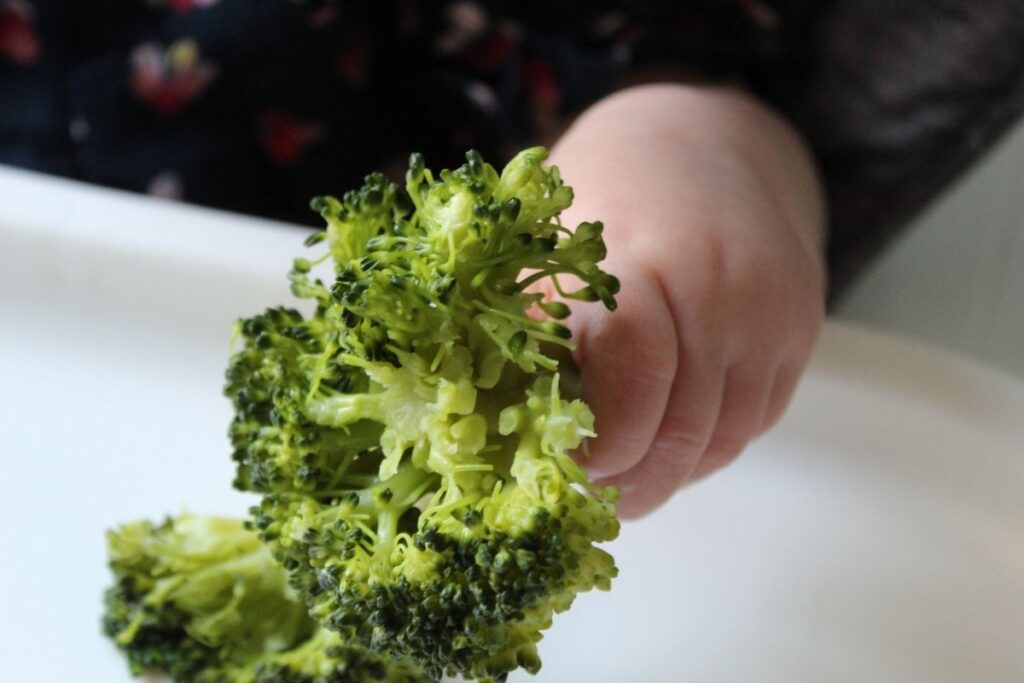
Root vegetable chunky chips think sweet potatoes!
Root vegetables are a favourite in many homes anyway. And babies love their sweeter taste. When they’re cooked, they’re perfect for younger babies. Simply, cut into a thick chip shape and cook till soft.
Choose from steamed carrot sticks, turnip, sweet potato wedges, regular potato, parsnip, beetroot or celeriac.
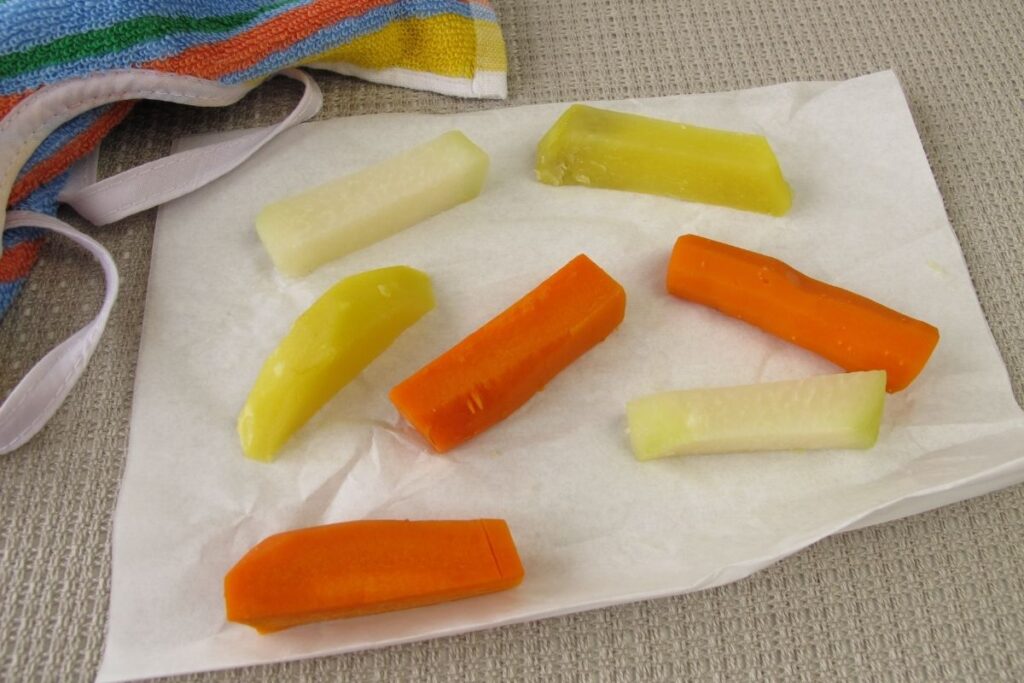
My best tip for cooking sweet potato!
Microwaving sweet potato is by far the quickest way to cook it for your baby. All you need is four-five minutes (depending on the size of the potato and the power of your microwave). So when you’re in a rush, this is definitely the easiest way to get finger food in front of your baby.
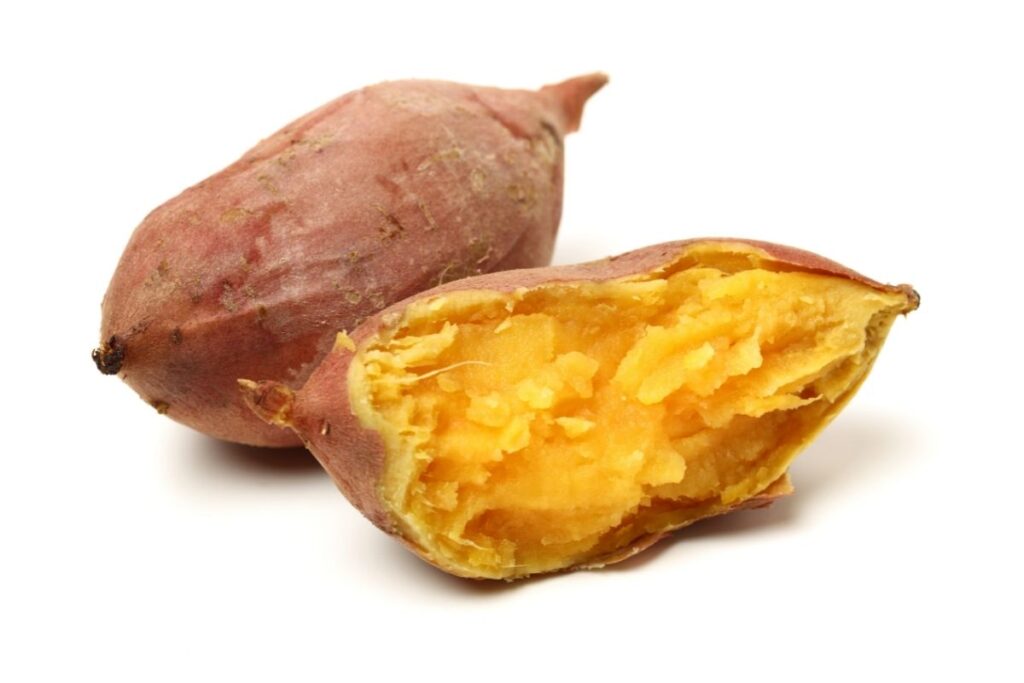
Wash and then prick the skin a few times. This allows any steam to escape. Set your microwave for four minutes. Then check to see if the sweet potato is tender. If it’s not, zap in 30-second intervals until it is.
You’ll know it’s cooked through when you can easily pierce all the way through the skin to the centre of the potato with a knife or skewer.
Then slice in half lengthways and use a dessertspoon to scoop out each half in one piece. Then slice lengthways into wedges. Cool and serve.
Soft ripe fresh fruit
I recommend offering more vegetables than fruit initially, but fruit is a convenient and nutritious first finger food. Make sure whatever fruit you choose is soft and ripe. You can leave a little skin on for grip but make sure you wash it first. Ripe kiwi, banana, orange, melon and pear are all great choices.
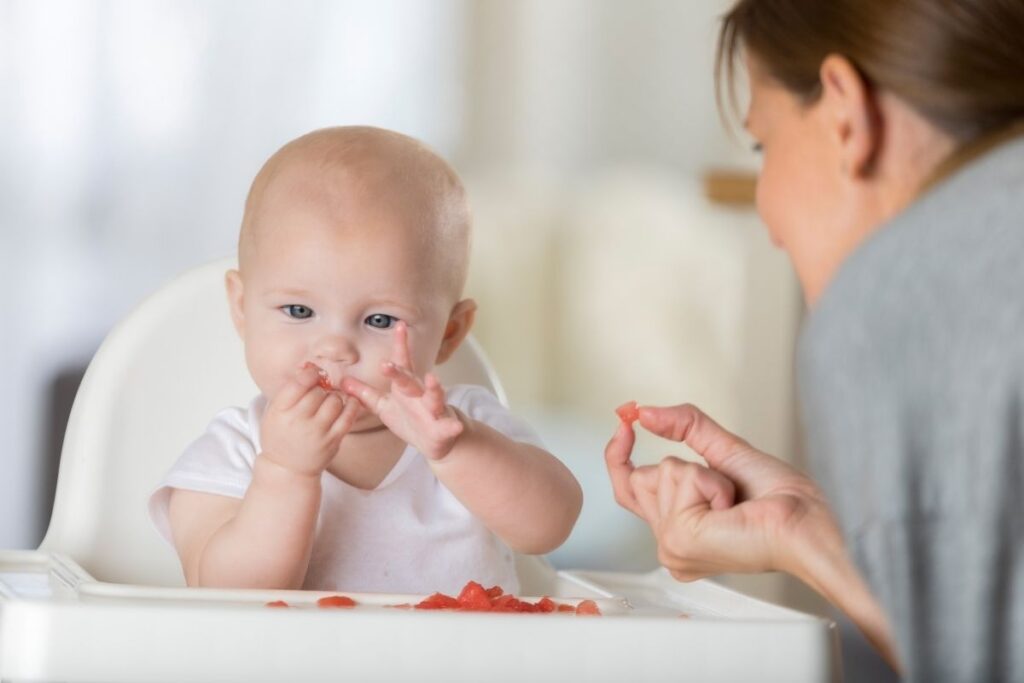
Serve raw fruit only if it’s very ripe and soft. Fruits like pear vary a lot in texture from rock hard to super squishy. If your pear is too hard, then steam, microwave or poach fruit to make it safe.
Top tip!
Leave your pear on the counter for a few days, alongside some bananas. Bananas (and apples) produce large amounts of ethylene gas, the so-called “fruit ripening hormone.”
Moving on from first finger foods
Now you and your baby are comfortable eating finger foods; it’s time to explore further.
Again, choose foods that form part of your regular family diet or that you’d like to be part of your diet.
Here are more advanced finger foods to consider
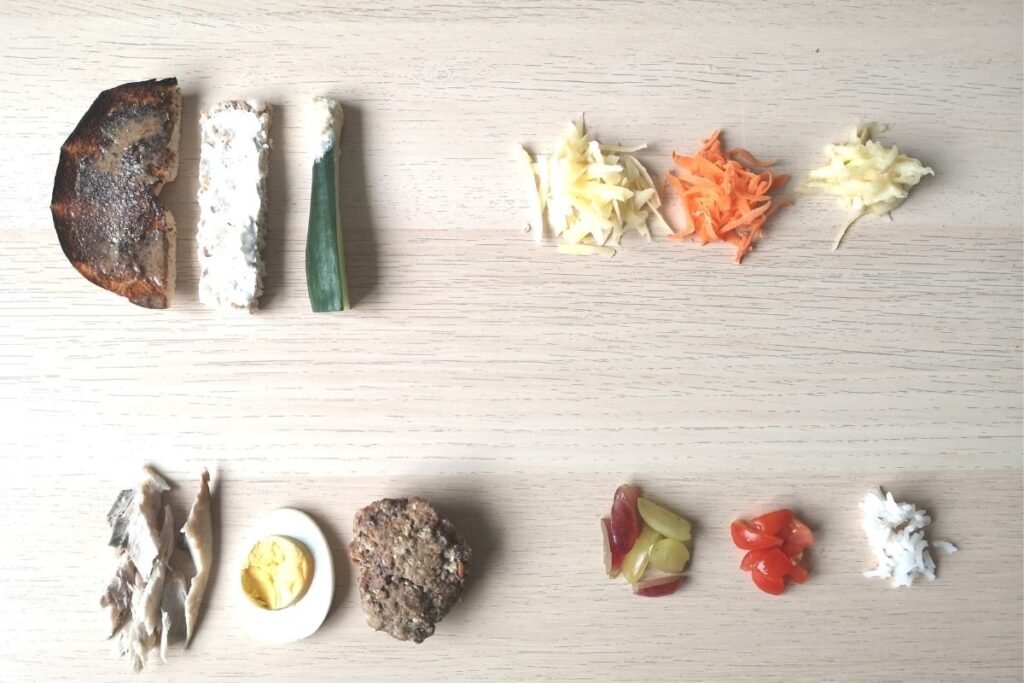
Foods giving other foods a ride that help with self-feeding
Toast, toasted bagels(choose the lowest salt content product), rice cakes, breadsticks and cucumber sticks are perfect vehicles for a thin spread of smooth peanut butter or other nut butter, hummus and yoghurt. You can even use mashed food like mashed banana or apple puree.
Fresh bread can be sticky so it’s better to lightly toast it before serving to your baby. When your baby’s competent with lightly toasted bread, you can start them untoasted. If you want to add butter then make sure that it’s unsalted or you drizzle with olive oil.
Choose from either white bread or bagels or choose whole grains like those made with whole wheat flour. A mixture of both is fine for babies.
Iron-rich finger food
Your baby needs iron-rich food at each meal too. So, make sure you don’t forget about offering flaked oily fish (carefully removing the bones), meatballs and mini burgers made from minced or ground meat like ground beef. White fish is good too although lower in iron.
Eggs are also a great source of iron, and you can serve as slices of a hard-boiled egg (strips of omelette or frittata). Scrambled eggs are handy later on.
Tofu is also an iron-rich food with a great texture. You can easily cut tofu into thin slices and serve as large, graspable finger food. Or serve it finely chopped once your baby has mastered the pincer grip.
Remember that plant-based sources of iron are harder to absorb so always pair these with a good source of vitamin C to help with absorption.
LEARN MORE >>> 9 iron-rich foods for babies you probably have in your kitchen already!
Grated finger foods for baby-led weaning.
Grating foods is a safe and straightforward way of serving food considered a choking hazard, like raw apple and raw carrot. Just wash, peel and then grate using the coarse side of the grater.
And who doesn’t love grated cheese?! Although cheese is salty, so serve in small amounts.
Grated food is super for improving fine motor skills. And it takes ages to eat, giving you lots of time to eat your own food!
Finger foods for baby that help with pincer grip practice
Once your baby has mastered its pincer grip, you can also start to offer smaller pieces of food. Remember to always chop round foods like grapes and cherry tomatoes lengthways.
Cooked rice and pasta are great for pincer grip practice. Another way to serve rice is to make the rice very soft and sticky and then roll it into rice balls that your baby can easily pick up. Frozen peas are super handy but they can be a choking hazard so make sure that you squash or halve them before serving them.
Next-level baby finger foods
There are plenty of finger food recipe ideas online for parents who have the time, skills and inclination to raise their finger food game. So if baking makes you happy. And you have the time, go for it. But if it doesn’t, that’s fine too; your baby won’t miss out if you just stick with the basic level finger food.
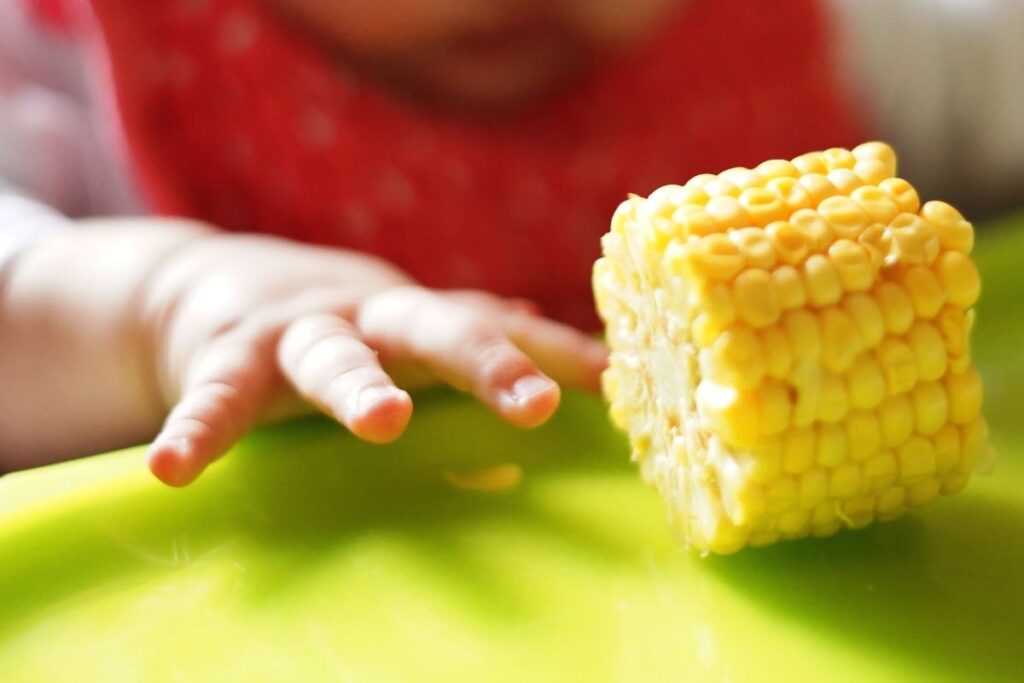
Searching for finger food or baby-led weaning recipes online? Keep these TIPS in mind:
Try to go for more savoury than sweet baby-led weaning recipes. You want to develop your baby’s taste buds during weaning, and they already have a preference for sweet tastes.
Avoid recipes that contain sugar, maple syrup and fruit purees. These are all forms of free sugars’ which your baby doesn’t need.
Continue to offer regular family meals as baby finger food. A diet centred exclusively around muffins and pancakes is no better than a diet reliant on 100% purees. Your baby needs a variety of tastes and textures during weaning.
The best foods for your baby are regular family foods, provided that these are suitable for your baby and that you have a reasonably healthy and varied diet.
Baby finger foods that take a bit more preparation
I’m no recipe developer! But I have pulled together some of my own recipes along with those from fellow dietitians and food bloggers so that you’ll never be short of ideas for finger foods for baby.
Here’s a round-up of a few of my favourite finger food recipes for babies!
Mini Muffins-great finger food for baby you can batch cook
Mini muffins are staples in the baby-led weaning world. And there’s literally no end to the combinations that you can use.
Peanut butter and banana porridge muffins– I developed this recipe so parents could keep peanuts in the diet. And it’s one of the most popular recipes on my blog.
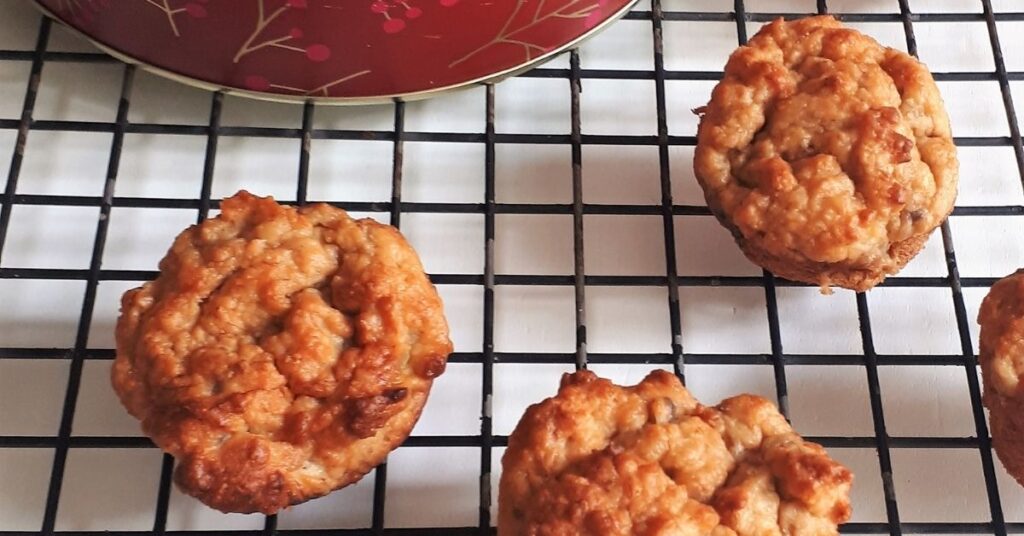
Cauliflower cheese egg muffins
Spinach and goats cheese muffins
Pancakes and Fritters make great baby finger foods
Pancakes and fritters are just as easy to make and popular as muffins. And again, you can pretty much find a recipe for any possible combination. Here are some of my favourites.
Easy Sweet Potato Pancakes– You’ll see lots of versions of these online. These are my take using iron-fortified oat cereal (or Ready Brek) to boost the iron content.
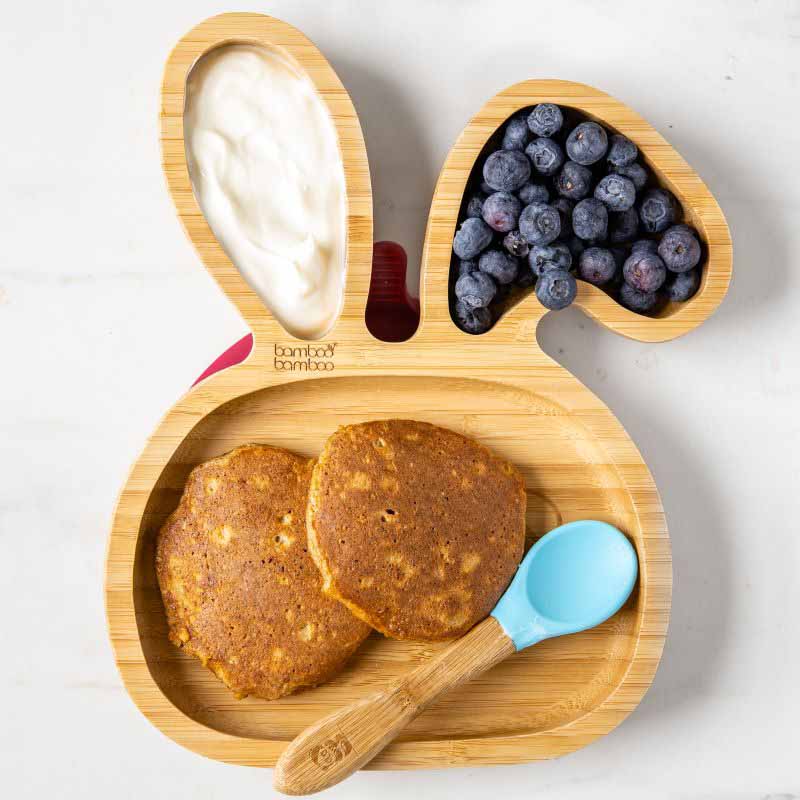
Pear and ginger pancakes-I make these a lot for my kids, and they’re still firm favourites around here.
Teething biscuits-these teething biscuits contain blitzed oats but you can use fortified oat cereal instead.
Iron-rich finger foods for babies (burgers, patties, cakes, meatballs)
I always advise offering iron-rich food at every meal. And if you want that to be finger food, then here are some easy ways to do it.
Tuna fish cakes. These fish cakes are made with store-cupboard ingredients so that you can knock them up in no time at all.
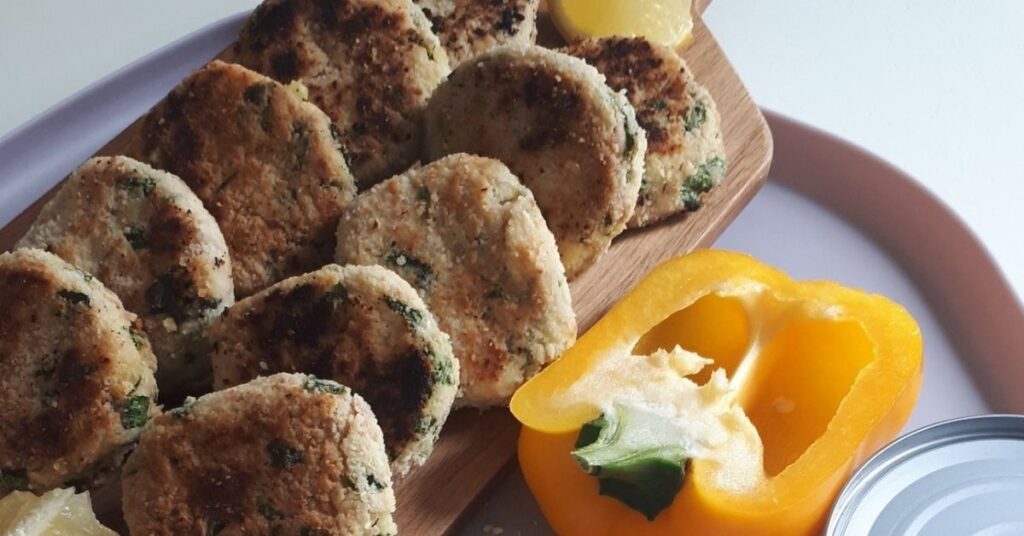
Veggie bean burgers are some of my most popular recipes and are loved by babies and their parents!
Mini meatballs– Who doesn’t love a meatball. Ground beef is highest in iron, but you can also vary by using other meats.
Savoury baby finger foods that make great out and about snacks
Carrot flapjacks– If you can read, grate and mix, you can make these.
Couscous fingers
I hope this has taken away some of the mystique about finger foods for babies. Remember they’re just foods that your baby can eat with their fingers!
And as always the more foods you offer your baby, the more they’ll learn about food. But always be baby-led. Your baby will let you know what and how much food they’re able for.
Want to know more about feeding your little guy or girl. Check out Ready, Steady, Wean-this self-paced online course will take you from confused to confident in no time at all.
And why not subscribe to Solid Start and get tips on food, nutrition and feeding straight to your inbox every month?
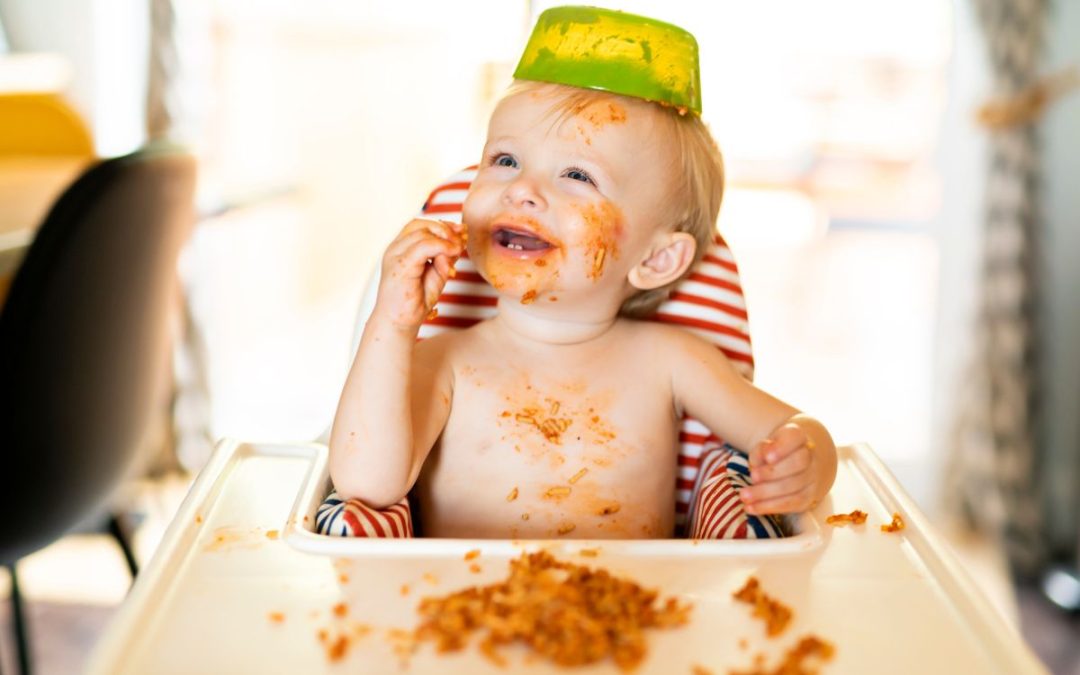
Iron Rich Foods for Babies: Your Guide to Confident Weaning
INSIDE: In this blog, we’ll discuss the essentials of iron-rich foods for babies, show you how easy it is to incorporate them into meals, and provide a free downloadable tip sheet with 9 iron-rich foods to simplify meal planning even more.You’re sitting at the table,...

Portion Sizes for Babies: The Easy Way to Know You’re Offering Enough
Portion sizes for babies aren’t about strict measurements. This guide shows you how to trust your baby’s hunger cues while offering balanced meals that suit their appetite.If you’ve ever found yourself staring at the spoon, wondering if that last bite was enough—or...
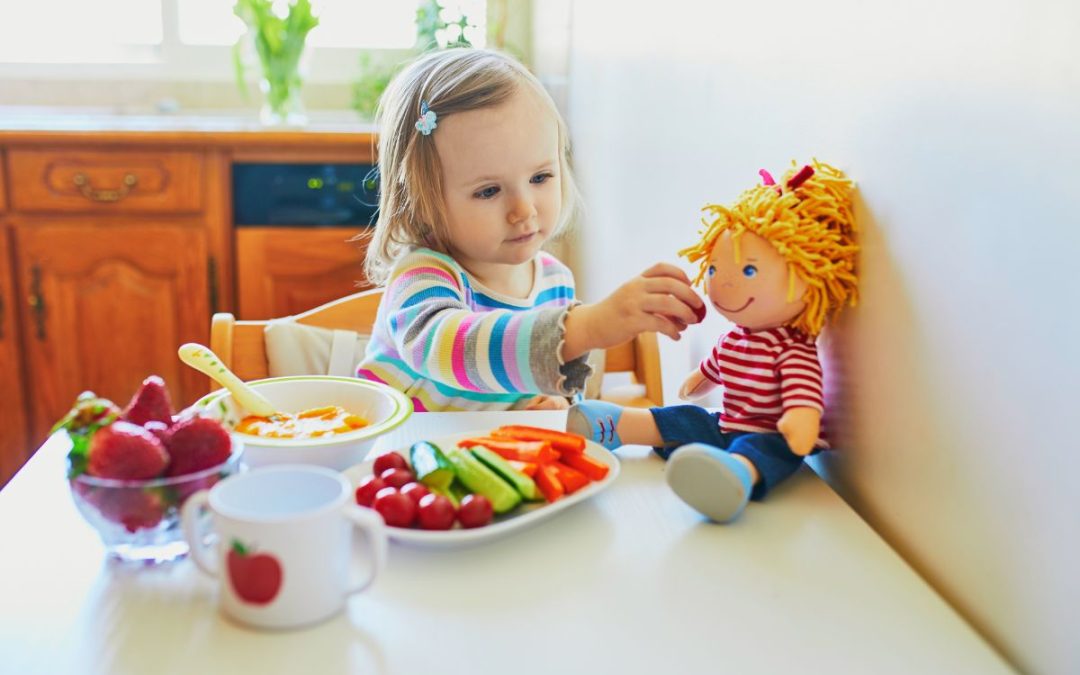
The Ultimate Easy Guide to Fruits for Toddlers (kid-approved!)
We would all love for our toddlers to embrace fruit as a regular part of their diet as it is so easy to prepare, tends to be in our kitchens anyway, and is an excellent source of hydration, vitamins, and fibre for our little ones. This is your questions answered about fruit for toddlers so you can feel confident implementing fruit into your toddler’s diet.

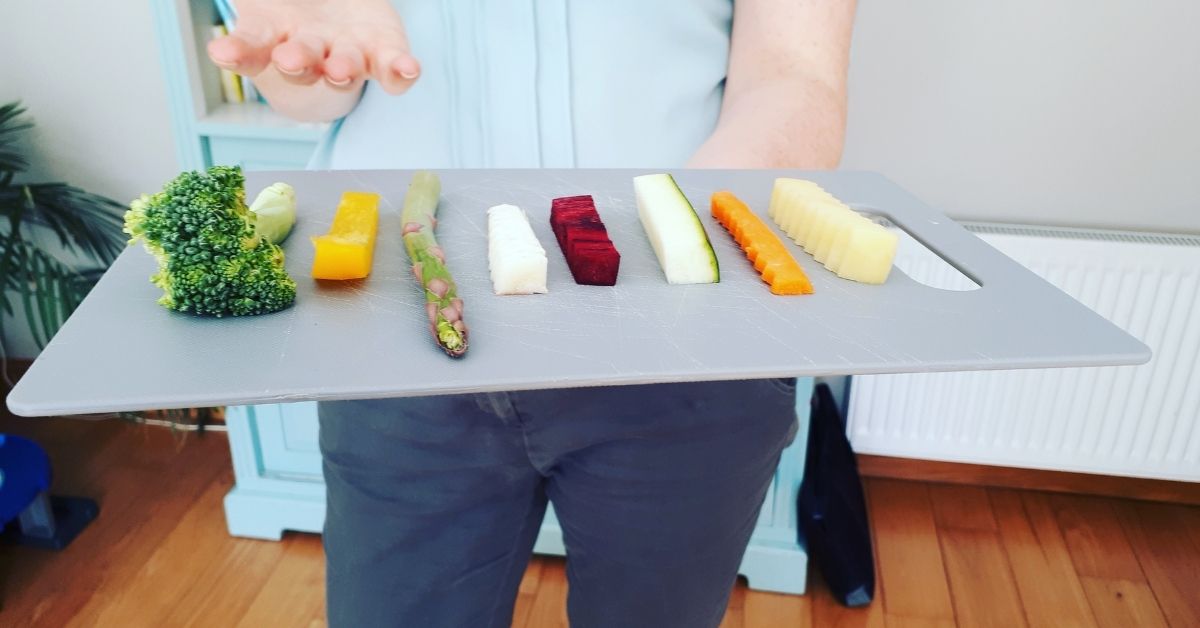

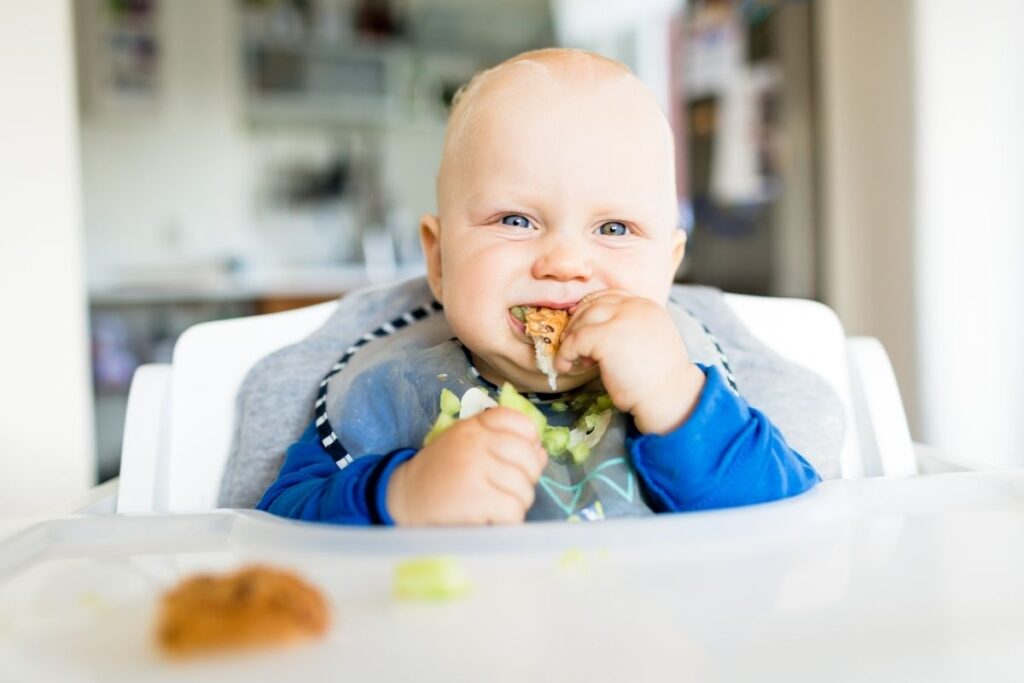
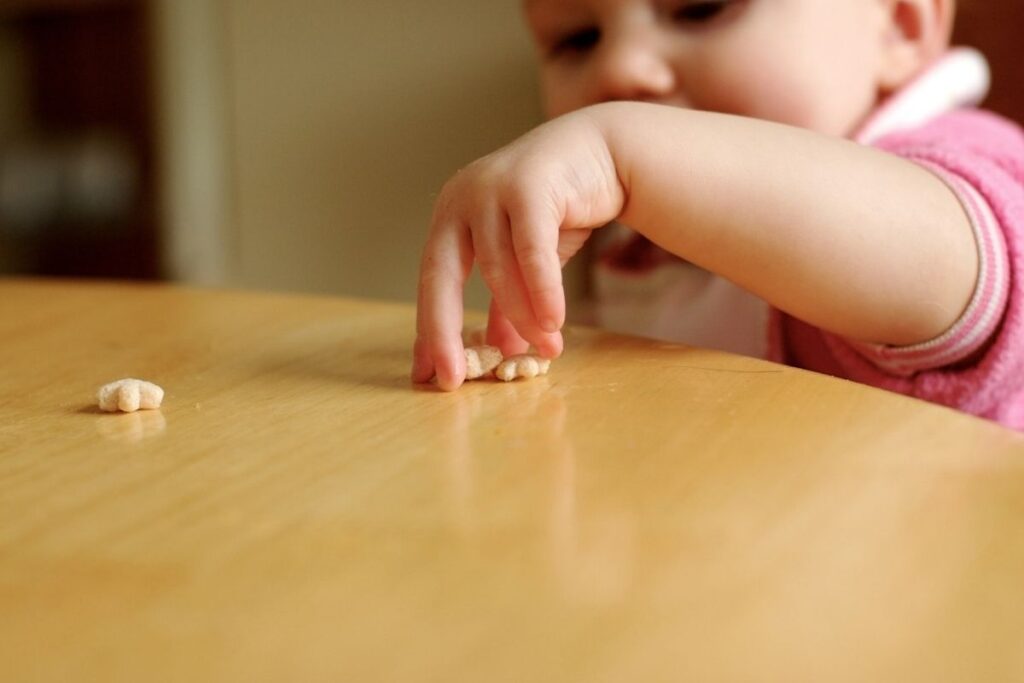


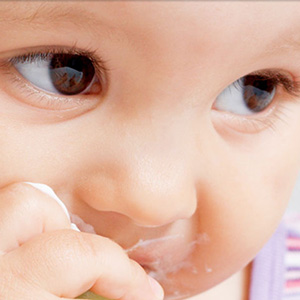


0 Comments